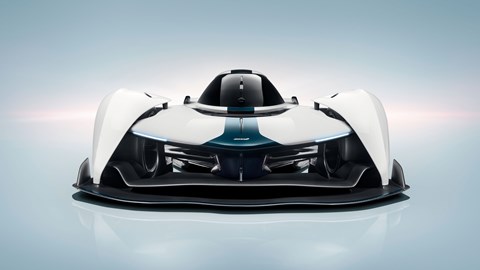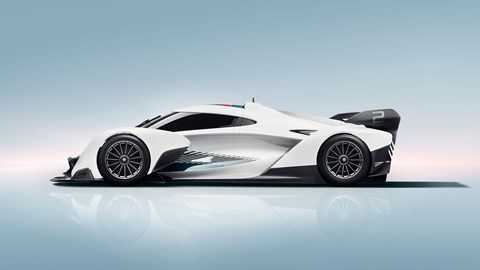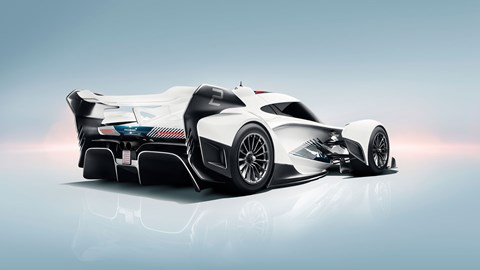► 25 track-only units, costing in excess of £3 million, all sold
► Top Gun-style sliding canopy, 5.2-litre V10 capable of 10,000rpm and ‘more than 828bhp’
► Weighs less than 1000kg, generates nearly 1400kg of downforce
Another day, another silly-money hypercar… Except that McLaren’s Solus GT is so much more than just another big-ticket, multi-turbo and ultimately compromised road-going statement piece.
Single-seat, with a bubble canopy like a fighter jet, legal only on racetracks, weighing in at around 950kg dry and powered not by some complex combination of combustion engine, turbos and e-motors, the Solus is total McLaren: everything the automotive division knows about high-performance, carbon-tubbed hypercars (quite a bit) poured into a machine of single-minded purpose and purity. It’s also McLaren Automotive saluting and celebrating F1, so key to its origin story and fundamental to its DNA, and specifically one magical era – when high-revving V10s shattered eardrums and snared hearts.

‘With this car we wanted to go back to McLaren’s roots,’ explains ultimate series line director Andy Palmer. ‘We continue to push light-weighting on all our cars, but the approach here was about going back to our DNA and the ideas Bruce had around power, weight and aero. We didn’t choose hybrid. The V10 is lightweight, it packages well and, putting aside the engagement and emotion of a normally-aspirated 5.2-litre V10 running at 10,000rpm, this is about giving our customers that purity and that link to F1 that we’ve never really been able to do before. Plus, it sounds absolutely awesome.’
Originally a 2017 vision concept for Gran Turismo Sport, the Solus GT is the first time one of the legendary game series’ concept cars had become a production reality. First customer cars will reach their very fortunate owners in early 2023. Track tests and development work continues in the meantime, with Bruno Senna involved.
How close to an F1 car is this thing?
For a car you can buy (theoretically at least), created for mortals, it’s close. Development driver Senna reckons the downforce is greater than that of an LMP2 racing prototype, if short of an LMP1 car. The engine also riffs heavily on the engines that ruled F1 in the ’90s. But the Solus GT bears no relation to McLaren’s 2022 F1 machine, and nor did McLaren’s F1 outfit consult directly on the design.

That said, as Palmer points out, such is the McLaren way that F1 thinking permeates every aspect of Automotive’s work. ‘Clearly the team is focused on the F1 programme. But we benefit from cross pollination. My chief engineer on ultimate series was Lewis Hamilton’s development engineer in his winning season with McLaren, and our head of advanced engineering was the head of aero for the F1 team during the Vodafone days.’
Where the Solus GT does resemble an F1 car is the way in which it was conceived around a no-compromise package: driver, engine, aerodynamics above all else and a bespoke carbon tub knitting these elements together with maximum stiffness and minimum weight.
The car is built around one of McLaren’s most radical tubs yet. Though the principles are similar to those used in the chassis of, say, the Artura, the processes here are more involved, with thousands of hours of work in the fastidious layering up of pre-preg carbonfibre. F1 thinking is evident in the layout of the chassis and the practice of using the engine and gearbox as stressed member, too, increasing rigidity with no weight penalty. The tub both forms the car’s core and is shaped by its uncompromising approach to aero, with the front splitter feeding airflow into vast under-body ground effect tunnels and ultimately a wicked-looking diffuser. Little carbon winglets and fins clean up the air around the front wheels, F1-style.

To the tub, the Solus GT mounts a 3D-printed titanium halo (which also serves as the V10’s air intake) and the suspension wishbones, which in turn carry the wheels in aerodynamic pods. The car uses double-wishbones all round, with pushrod actuation up front and pullrods at the rear, working torsion bars and four-way, manually-adjustable dampers. Adjustable front and rear anti-roll bars, a heave spring and damper (to help maintain a consistent attitude and ride height for the aerodynamics) and ride-height springs complete the exotic and high-performance suspension layout.
The 18-inch forged alloy rims mount wet or slick rubber, and mount to ceramic discs and six-piston forged brake calipers, with the brake bias manually adjustable from the cockpit. Prospective owners will be relieved to hear there’s a full suite of driver-assist electronics, including motorsport-derived ABS and traction control – as with the P1 and Senna GTRs, McLaren’s taking as responsible approach a approach to outlandish performance as it possibly can… important when the numbers are 0-62mph in 2.5sec and a top speed north of 200mph.

‘These owners are on this journey with us, and we can offer them that progression through from cars like the 600LT through Senna and Senna GTR, with increasing performance and downforce,’ explains Palmer. ‘They’ll also drive prototypes so they’re familiar with the car before they drive theirs. We’ve also worked to ensure the car is user-friendly. For instance, drivers often stall an F1 car the first time they drive one [the Solus uses a sequential gearbox and tiny carbonfibre clutch]. We have an auto pull-away, linked to the software, so getting the car moving is relatively easy and straightforward. And, at speed, the way we deliver the downforce is very progressive. It’s about the tyres, too [LMP Goodyears]. Yes, they need to be warm. But they’re nothing like as temperature-critical as F1 tyres. We’ll also offer a range of base set-ups, including for some of our owners who have their own private circuits. But there’s then obviously huge scope for changing the set-up to suit each driver and what they want from their car.’
Yes, yes. Talk to me about this engine
Sorry, yes. Let’s cut the chase.
Aston’s Valkyrie offers a naturally-aspirated, 6.5-litre Cosworth V12 making north of 1000bhp. The latest versions of Ferrari’s V12, also 6.5 litres, offers 828bhp. The Solus GT’s motorsport-derived V10 is altogether more serious, being lightweight (130kg) and more compact while also offering a five-figure rev ceiling and more power than Ferrari’s V12 SP3 Daytona from a smaller displacement.
But this isn’t McLaren U-turning from its hybrid, turbocharged V6 and ultimately electric future. The Solus GT doesn’t denote a future direction for either McLaren design or engineering – more a fascinating side hustle for its most committed owner/enthusiasts. As such the V10 is not a new in-house creation, and is instead based on a unit from motorsport specialists Judd. It’s extensively optimised for, and specified by, McLaren for this installation, with a unique crank, capacity, intake system and exhaust. Purists will delight in the use of gear-driven camshafts, which ensure accurate valve actuation at any engine speed and remove all worries of snapped belt or chain mechanical carnage…

‘This engine’s unique, and it’s been developed specifically for us,’ explains Palmer. ‘But, like us, Judd has this heritage. They created those amazing F1 engines that were successful back in the ’90s.’ Judd’s 3.5-litre V8 was the fastest non-turbo F1 engine of the ’80s, scoring its first podium in the back of Mansell’s Williams in the 1988 British Grand Prix, and its V10 – later badged as a Yamaha – was equally competitive, with Damon Hill’s Arrows finishing second in Hungary in ’97. More recently, Judd V10s have proven powerful and reliable in sportscar racing.
The Solus GT’s V10 drives the rear wheels via a seven-speed sequential gearbox, whose specification is pure motorsport: carbon clutch, straight-cut gears (these, together with the gear-driven cams, will make for the most gorgeous mechanical racket…) and an exotic, aluminium-and-magnesium construction.
How will it drive?
Relevant points of reference are few and far between, but Bruno Senna raves about the grip, the braking performance, the startling visibility afforded by the bubble canopy and that engine, which he says is tractable and torquey as well as being ballistic at the business end of the rev range. He also points out that customers’ neck muscles may struggle in the face of the Solus GT’s downforce and cornering speeds…

As important as the car’s outright performance, though, is the theatre of the thing. Just climbing aboard will be a moment to savour, thanks to the unique sliding bubble canopy. Picture the moment. Long ago you had your F1-style seat fitting, and you’re already comfortable in your FIA-approved racesuit, HANS device and helmet. You’ve also had your driving skills buffed by McLaren’s driver programme – a good thing, given the idea of booking onto a public trackday in this thing and not being absolutely the fastest thing out simply doesn’t bear thinking about.
Now, with the canopy open, place your foot on the vent on the side of the cockpit that also works as a step for entry. Jump in through the canopy, salute the tower (sorry, just watched Maverick) and make yourself comfortable by pulling the catch to bring the pedalbox to your feet. The main driver controls and TFT display are on the removable carbonfibre steering wheel, and a screen above shows the feed from the wide-screen rear-view camera up on the roll hoop. The final bit of outrageously cool fighter jet-inspired design? Controls for engine ignition and the fire extinguisher system on a panel above your head…
Wait for the thumbs-up from your crew (the Solus GT doesn’t require an F1 team to run it, but the engine does need pre-warming to avoid damage given its super-tight tolerances – a failsafe prevents it starting if it’s not up to temperature), fire the V10 and go enjoy yourself.